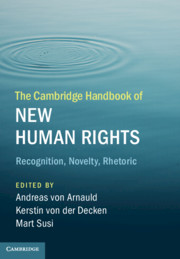Book contents
- The Cambridge Handbook of New Human Rights
- The Cambridge Handbook of New Human Rights
- Copyright page
- Contents
- Figures
- Contributors
- Acknowledgements
- Introduction
- Part I Cross-Cutting Observations
- Part II Public Good Rights
- Part III Status Rights
- Rights of Older Persons
- Rights to Gender Identity
- Rights of Indigenous Peoples
- 16 The Rights of Indigenous Peoples
- 17 The Evolution and Revolution of Indigenous Rights
- Animal Rights
- Part IV New Technology Rights
- Part V Autonomy and Integrity Rights
- Part VI Governance Rights
- Index
17 - The Evolution and Revolution of Indigenous Rights
from Rights of Indigenous Peoples
Published online by Cambridge University Press: 04 January 2020
- The Cambridge Handbook of New Human Rights
- The Cambridge Handbook of New Human Rights
- Copyright page
- Contents
- Figures
- Contributors
- Acknowledgements
- Introduction
- Part I Cross-Cutting Observations
- Part II Public Good Rights
- Part III Status Rights
- Rights of Older Persons
- Rights to Gender Identity
- Rights of Indigenous Peoples
- 16 The Rights of Indigenous Peoples
- 17 The Evolution and Revolution of Indigenous Rights
- Animal Rights
- Part IV New Technology Rights
- Part V Autonomy and Integrity Rights
- Part VI Governance Rights
- Index
Summary
In her excellent chapter, Dinah Shelton documents that indigenous peoples’ rights have assumed a prominent place in international human rights law and that a discrete body of law, affirming and protecting their rights, has emerged. While it has deep historical roots, this body of law began to take its current form in the mid-1980s, gathered speed around the turn of the millennium with an explosion of jurisprudence, and was given greater impetus with the adoption of the UN Declaration on the Rights of Indigenous Peoples (UNDRIP) in 2007. More recent jurisprudence and standards, particularly at the regional level, and various global initiatives have continued this process, including in relation to ‘implementation’ of the UNDRIP. Sustained and highly effective advocacy by indigenous peoples has been central to these developments.
- Type
- Chapter
- Information
- The Cambridge Handbook of New Human RightsRecognition, Novelty, Rhetoric, pp. 233 - 240Publisher: Cambridge University PressPrint publication year: 2020



